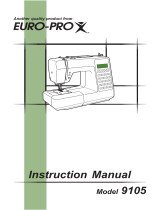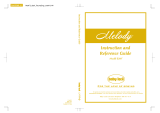
5
— — — — — — — — — — — — — — — — — — — — — — — — — — — — — — — — — — — — — — — — — — — — — — — — — — —
SEWING BASICS 49
Sewing...............................................................................................................................50
General sewing procedure .............................................................................................................................. 50
Positioning the fabric ......................................................................................................................................51
Starting to sew.................................................................................................................................................52
Securing the stitching ......................................................................................................................................54
Cutting the thread ...........................................................................................................................................55
Adjusting the Thread Tension ............................................................................................57
Thread tension ................................................................................................................................................57
Changing the tension of the upper thread ....................................................................................................... 58
Adjusting the Stitch Width and Length ..............................................................................59
Adjusting the stitch width................................................................................................................................ 59
Adjusting the stitch length...............................................................................................................................60
Useful Functions................................................................................................................61
Changing the needle stop position ................................................................................................................. 61
Automatically sewing reverse/reinforcement stitches............................................................................................... 61
Automatically cutting the thread .................................................................................................................... 63
Saving stitch settings .......................................................................................................................................64
Hands-free raising and lowering of the presser foot ........................................................................................ 65
Useful Sewing Tips ............................................................................................................66
Trial sewing ....................................................................................................................................................66
Changing the sewing direction................................................................................................................................. 66
Sewing curves .................................................................................................................................................66
Sewing thick fabrics ........................................................................................................................................67
Sewing thin fabrics..........................................................................................................................................67
Sewing stretch fabrics......................................................................................................................................67
Sewing leathers or vinyl fabrics ...................................................................................................................... 68
Sewing an even seam allowance.................................................................................................................... 68
Sewing hook-and-loop fastener .......................................................................................................................68
UTILITY STITCHES 69
Selecting Stitching .............................................................................................................70
Selecting stitch types and patterns .................................................................................................................. 70
Selecting stitching ...........................................................................................................................................72
Overcasting Stitches..........................................................................................................76
Sewing overcasting stitches using overcasting foot “G” ...................................................................................76
Sewing overcasting stitches using zigzag foot “J”............................................................................................. 77
Sewing overcasting stitches using the side cutter ............................................................................................. 78
Basic Stitching ...................................................................................................................80
Basting............................................................................................................................................................80
Basic stitching .................................................................................................................................................81
Blind Hem Stitching ..........................................................................................................82
Buttonhole Stitching/Button Sewing..................................................................................84
Buttonhole sewing ..........................................................................................................................................85
Button sewing .................................................................................................................................................89
Zipper Insertion.................................................................................................................91
Inserting a centered zipper ..............................................................................................................................91
Inserting a side zipper .....................................................................................................................................93
Zipper/piping Insertion .....................................................................................................96
Inserting a centered zipper ..............................................................................................................................96
Inserting a piping ............................................................................................................................................97
Sewing Stretch Fabrics and Elastic Tape ............................................................................98
Stretch stitching...............................................................................................................................................98
Elastic attaching ..............................................................................................................................................98
Appliqué, Patchwork and Quilt Stitching ........................................................................100
Appliqué stitching .........................................................................................................................................101
Patchwork (crazy quilt) stitching .................................................................................................................. 102
Piecing..........................................................................................................................................................102























